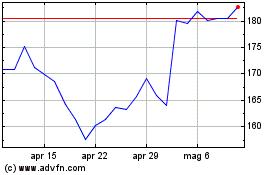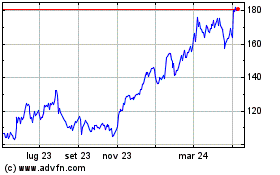By Eliot Brown and Bob Davis
Qualcomm Inc. scrapped its $44 billion purchase of Dutch chip
maker NXP Semiconductors NV after a Wednesday deadline to gain
approval in China passed, making the deal one of the most prominent
victims of spiraling U.S.-China trade tensions and derailing a
central part of the U.S. chip giant's strategy.
China was the last of nine markets that needed to approve the
deal, which would have been among the biggest ever between
technology companies. The acquisition was announced in October 2016
and extended in April as the chip makers sought approval from
China's competition regulators.
Instead, the deal became mired in Beijing's trade fight with
Washington.
Qualcomm said Thursday it terminated the agreement with NXP
after it expired late Wednesday. NXP is due to collect a $2 billion
breakup and announced plans for a $5 billion share buyback.
Qualcomm's decision to walk away follows a round of last-minute
lobbying on the company's behalf by senior U.S. officials including
Treasury Secretary Steven Mnuchin and Commerce Secretary Wilbur
Ross, who tried to persuade their Chinese counterparts to separate
the deal's approval process from broader trade tensions, U.S.
industry executives said.
Chief Executive Steve Mollenkopf told analysts Qualcomm's
decision was "a difficult one," but that the company didn't believe
"a change in the current geopolitical environment" was likely in
the near future.
The deal's demise puts a leading U.S. technology company atop a
list of those affected by the trade battle, which has produced
tit-for-tat tariffs by the U.S. and China on billions of dollars of
goods across a range of industries.
"It's not just a trade war anymore," said Eswar Prasad, a
Cornell University economist who was a senior International
Monetary Fund China specialist. "It's becoming a more open economic
conflict between the two countries." The deal's collapse, he said,
"certainly is a strong signal that China is going to use every
available lever."
The Chinese Embassy didn't respond to a request to comment, but
a Chinese Ministry of Commerce spokesman rejected suggestions that
China's inaction was influenced by the bilateral trade fight.
"As far as I know, the case is a matter of antitrust law
enforcement," the spokesman said. "It has nothing to do with
China-U.S. trade frictions."
Qualcomm said it plans to spend up to $30 billion buying its own
stock to placate shareholders, replacing an existing $10 billion
buyback plan. The collapse of the planned merger also requires the
San Diego chip maker to pay a $2 billion termination fee to NXP,
based on their renewed agreement in April.
The deal's termination came as Qualcomm said profit jumped 41%
in its latest quarter on a 4% gain in revenue. The big jump in
profit partly reflects a comparison to a year-earlier quarter that
was the first in years to not include patent royalties from Apple
Inc. devices.
Qualcomm executives also told analysts they expect their modems
wouldn't be used in the next iPhone, a move expected by
investors.
The end of the NXP pursuit caps a remarkable period of tumult
for Qualcomm, the world's top producer of communications chips used
in smartphones and other gear.
Just four months ago, the Trump administration intervened to
save Qualcomm from a $117 billion hostile takeover by Broadcom Ltd.
on the grounds that Qualcomm's technology was vital to U.S.
national security. Qualcomm is a U.S. leader in the development of
so-called fifth-generation, or 5G, cellular technology that will
help connect a slew of new devices to wireless networks, and the
White House's intervention effectively designated Qualcomm a
national champion essential to battling China's rising might in
5G.
Qualcomm had billed the NXP deal, announced 12 days before
Donald Trump was elected president, as transformational, expanding
its reach beyond smartphones into areas such as automobiles and
smart-home devices. The deal would have added a company with $9.26
billion in revenue last year and some 30,000 employees to Qualcomm,
which had $22.29 billion in sales in its latest fiscal year and a
similar number of employees.
Qualcomm shares rose more than 5% in after-hours trading to
nearly $63, though they remain below the nearly $69 level they
traded at in January, when Broadcom pursued it. NXP, meanwhile,
fell more than 3% as it now faces a future as a standalone
company.
Originally expected to close by the end of last year, the NXP
deal was approved by eight other regulatory bodies, including in
the U.S. and Europe. But it dragged with China's antitrust
authority, which has broad reach to claim say over deals in which
at least one party has a significant presence in the Chinese
market.
As the deal languished, trade tensions between the U.S. and
China escalated from bellicose rhetoric to tariffs by each side
that are aimed at $50 billion of imports from the other. Mr. Trump
has threatened to put tariffs on all $505 billion of Chinese
imports into the U.S.
With the clock ticking down to Wednesday's expiration, Mr.
Mnuchin spoke with Chinese Vice Minister Liu He to push for
approval, and Mr. Ross did the same with China's ambassador to the
U.S., Cui Tiankai, according to the U.S. industry executives.
The U.S. officials argued the Qualcomm decision should be made
on the merits of the deal. Spokesmen for the Treasury and Commerce
departments declined to discuss the U.S. government's efforts.
Their moves came after President Trump worked to ease U.S.
penalties on ZTE Corp. so that the Chinese telecommunications giant
could continue to operate after it was found to have violated U.S.
sanctions on North Korea and Iran. Some U.S. government and
industry officials had expected the ZTE efforts would prompt China
to reciprocate and approve the Qualcomm-NXP deal.
Qualcomm reported $1.22 billion in net income for its fiscal
third quarter. Revenue came in at $5.6 billion. The results were
buoyed by a $500 million partial settlement in a patent dispute
with an unnamed company that licenses Qualcomm technology. The
company has previously been identified as Huawei Technologies Co. A
Huawei spokesman didn't respond to a request to comment.
Still, the NXP deal's collapse adds pressure on Qualcomm and Mr.
Mollenkopf, who failed to win majority support from shareholders in
a March board-election vote. Closing the NXP deal was seen as an
important step toward restoring investor confidence after
Qualcomm's shares lost over a quarter of their value in the past
four-plus years, while the PHLX Semiconductor Index has more than
doubled.
--Yoko Kubota contributed to this article.
Write to Eliot Brown at eliot.brown@wsj.com and Bob Davis at
bob.davis@wsj.com
(END) Dow Jones Newswires
July 26, 2018 08:16 ET (12:16 GMT)
Copyright (c) 2018 Dow Jones & Company, Inc.
Grafico Azioni QUALCOMM (NASDAQ:QCOM)
Storico
Da Mar 2024 a Apr 2024

Grafico Azioni QUALCOMM (NASDAQ:QCOM)
Storico
Da Apr 2023 a Apr 2024
